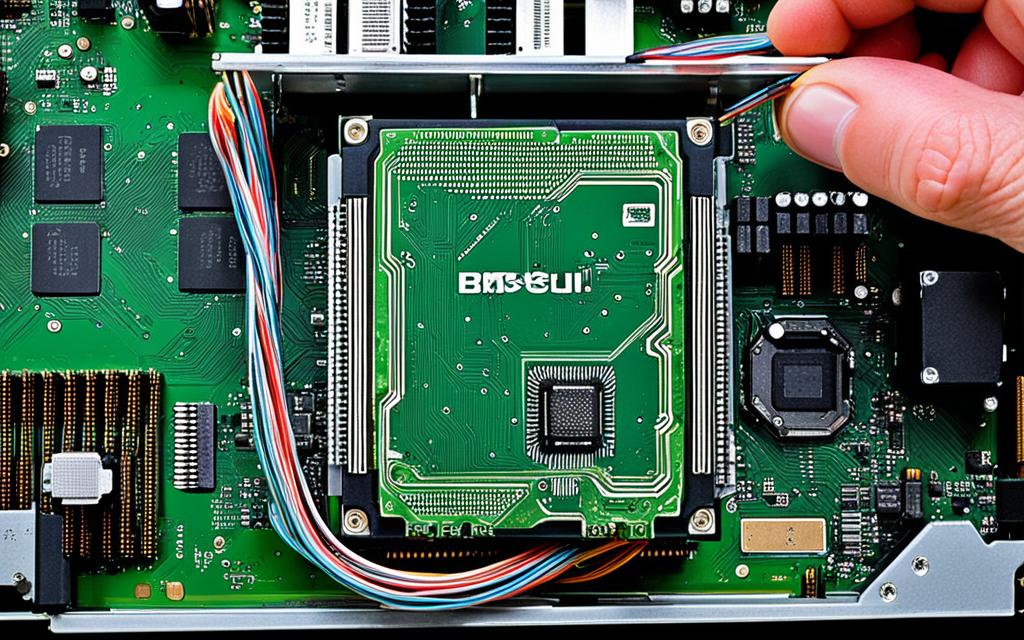Table of Contents
Reseating your CPU can really boost your computer’s work and reliability. In today’s world, it’s key for anyone who loves tech or just needs their computer to work better. This guide shows you the important steps for reseating your CPU correctly. It tells you why it matters and the best tools and ways to do it. If you ignore this, your CPU might overheat and not work as well, which is something we all want to avoid.
Want more tips on how to reseat your CPU? Check out this useful guide. Knowing all about reseating your CPU means you’re ready to fix any issues that come up.
Key Takeaways
- The CPU may need reseating if you experience performance issues or system failures.
- Proper thermal paste application is essential for optimal CPU performance.
- Regular maintenance can prevent overheating and loud fan noises in your CPU.
- Use the correct tools and follow the right sequence when reseating components.
- Ensure all components are properly aligned before powering up your PC.
Understanding the Importance of Reseating Your CPU
Reseating your CPU is a crucial maintenance step. It keeps your computer working well. The importance of reseating is about fixing hardware problems due to bad connections or parts not aligning right over time.
What Does Reseating Mean?
Reseating means taking the CPU out and putting it back in. This ensures a strong connection in its socket. It’s done to fix issues like dust build-up, changes due to heat, or shaking from regular use. Doing this helps keep your CPU running smoothly.
Signs That You May Need to Reseat Your CPU
Knowing when to reseat is key for computer users. Look for signs like unexpected system crashes, drops in performance, or the computer not recognizing parts. These could mean it’s time to reseat.
Potential Benefits of Reseating
The benefits of CPU reseating include better performance and stability. Reseating helps with overheating by improving heat removal. It also fixes graphical problems and makes your computer run smoother. When you’re upgrading your CPU, reseating ensures it works well and brings the improvements you’re looking for.
| Benefits of Reseating | Description |
|---|---|
| Enhanced Performance | Improves CPU functionality and responsiveness. |
| Increased Stability | Reduces the chances of system crashes and freezes. |
| Better Heat Dissipation | Minimises overheating risks by improving cooling efficiency. |
| Compatibility | Ensures optimal connections during processor upgrades. |
| Improved Multithreaded Performance | Stabilises workload distribution across CPU cores. |
Reseating is not just a technical task. It’s a forward-thinking step that boosts your computer’s efficiency and reliability123. Doing this helps your system work at its best.
Gathering the Necessary Tools and Components
Before you start reseating your CPU, make sure to collect all the tools and components. This step ensures everything goes smoothly and reduces risks. Knowing the right tools for reseating your CPU makes the process efficient and reliable.
Essential Tools for Reseating
To reseat your CPU properly, you need the correct tools. Here’s a list of what’s necessary:
- Screwdrivers (preferably Phillips head)
- Anti-static wrist straps to prevent electrostatic discharge
- Lint-free cloths or isopropyl alcohol for cleaning
- Thermal paste (after removal, fresh application is necessary)
Having a clean workspace is also crucial as dust can hinder the reseating process. Ensure your area is clean and free from any particles.
Choosing the Right Thermal Paste
It’s important to select a high-quality thermal paste for your CPU’s best performance. Brands like Arctic Silver and Noctua NT-H1 are top choices for efficient cooling. Be sure to remove old thermal paste completely before applying a new layer. The right thermal paste selection prevents overheating and keeps your CPU running smoothly.
Safety Equipment to Consider
It’s essential to focus on safety when reseating your CPU. Wear anti-static wrist straps and make sure your environment is free from static. Before you begin, turn your computer off and unplug it to avoid electrical shocks.
By following these steps, you ensure a successful CPU reseat and maintain your system’s reliability and performance. Gathering the right tools and focusing on safety is key for a hassle-free reseating process. Remember, preparing well is crucial in tech tasks45.
How to Reseat Your CPU: Step-by-Step Guide
Reseating your CPU can seem tough, but it’s doable with clear steps. Our guide makes it easy for anyone who’s patient. It ensures your computer runs better and smoother.
Preparing Your Computer for Reseat
First, turn off and unplug your computer for safety. Then, take off the side panels with a screwdriver. Make sure all power sources are off. This avoids damage and helps with problems like RAM issues6.
Removing the CPU Cooler Safely
It’s key to remove the CPU cooler gently. Move it side-to-side, not pulling it upwards. Sometimes it sticks because of the thermal paste. Moving it gently stops parts from breaking7.
Cleaning the CPU and Socket Area
After the cooler is off, clean the CPU and its socket. Use a soft cloth and canned air for dust. Make sure everything’s clean and check for damage. Cleaning well helps parts work better after reseating8.
Reinstalling the CPU and Cooler
To put the CPU back, make sure it fits right. Then, put on a small amount of thermal paste. Fit the cooler back tightly. This helps your computer stay cool and stable78.
Common Mistakes to Avoid When Reseating Your CPU
Reseating your CPU can boost performance. Yet, some mistakes can lower the benefits. Knowledge of these errors ensures a smoother process.
Using Too Much or Too Little Thermal Paste
It’s vital to get the thermal paste amount just right. Applying too much can cause it to overflow, leading to electrical shorts. On the other hand, too little paste overheats the CPU. Over time, thermal paste dries out and cracks, reducing its effect. Thus, it’s important to replace old thermal paste to keep up performance910.
Not Handling Components Gently
It’s critical to handle CPU parts with care. CPU pins, being fragile, can get easily damaged. Make sure to treat all parts gently to prevent damage that can’t be fixed. Incorrect handling might cause hardware to fail, so always be cautious.
Ignoring Electrical Safety Precautions
Always start by ensuring you’re safe. Make sure your computer is off and unplugged. This avoids shocks or damaging your PC. Using an anti-static strap helps protect against static harm to your equipment.
Additional Tips for Ensuring Optimal Performance
Regular maintenance and monitoring are key for great CPU performance. Computer maintenance ensures your system runs smoothly. It also lowers the chance of overheating. Overheating can cause slowdowns or even sudden shutdowns.
Regular Maintenance and Cleaning
Keeping the inside of your computer clean is crucial for your CPU’s life. Dust can hurt performance by blocking airflow. This leads to overheating. Cleaning every few months keeps airflow good11.
Using better thermal paste, like Arctic Silver, can improve heat flow11. For cleaning thermal interfaces, use isopropyl alcohol that’s 90% or stronger12. A pea-sized amount of new thermal paste works best for most CPUs. It helps manage heat well12.
Monitoring for Potential Issues Post-Reseat
It’s important to watch your system’s performance after reseating the CPU. Look out for any signs of trouble. Things like frequent crashes or strange noises might mean the CPU wasn’t seated right13.
Keeping an eye on CPU temperature helps manage heat. Better cooling methods can lower CPU temperatures. This is especially true when your system is under a lot of stress13.
| Maintenance Activity | Frequency | Benefits |
|---|---|---|
| Cleaning Dust | Every 3-6 months | Improves airflow, prevents overheating |
| Thermal Paste Upgrade | Every 1-2 years | Enhances heat dissipation |
| CPU Temperature Monitoring | Continuous | Prevents performance throttling |
Conclusion
Reseating your CPU is key to making sure your computer works its best. It helps stop overheating and keeps the system running smoothly. The CPU is like the brain of your computer. It does all the important calculations. Keeping it well-connected is critical for it to work properly14. A step-by-step guide on CPU reseating can fix performance problems caused by loose connections. These issues might not be obvious until your system starts acting up15.
To reseat your CPU correctly, you need the right tools. This includes thermal paste and cleaning supplies. With these tools, you can boost your computer’s performance. This process makes sure all parts of your computer work well together14. Then, keeping an eye on your computer after the reseating helps maintain these improvements. It leads to a better experience for users and a more dependable system over time.
FAQ
What does the term ‘reseating’ mean in computing?
Reseating is when you take out and then put back a CPU or another part of the computer. This ensures a strong, secure connection. It fixes issues that happen when connections get loose because of dust, temperature changes, or shaking.
How can I tell if I need to reseat my CPU?
You might need to reseat your CPU if your computer often fails or crashes. Other signs include poor performance and if the computer does not recognise certain parts. Reseating can solve these connectivity issues, especially if the computer doesn’t start.
What tools do I need to reseat my CPU effectively?
You need a few things to reseat your CPU properly. These include a screwdriver with a Phillips head and anti-static wrist straps to avoid electric shock. A soft cloth might also help for cleaning. It’s important to work in a place that’s free of dust.
Why is it important to use the right thermal paste?
Using the right thermal paste, like Arctic Silver, is crucial. It ensures heat moves effectively between the CPU and its cooler. Putting on fresh thermal paste gets rid of old, ineffective material that can affect your CPU’s performance.
What safety precautions should I take when reseating my CPU?
Safety first means wearing anti-static wrist straps and choosing a static-free place to work. Always turn off and unplug your computer first to avoid electric shock.
What steps should I follow when preparing my computer for reseating?
Begin by turning off your computer and unplugging it. Next, use a screwdriver to take off the side panels. Make sure all electrical connections are cut off before you start working on the reseating.
How do I safely remove the CPU cooler?
Remove the CPU cooler carefully. Move it side to side instead of pulling straight up. Be gentle—the cooler might stick because of the thermal paste. This way you avoid damaging anything.
What are the common mistakes to avoid when reseating a CPU?
Avoid putting too much or too little thermal paste on. Also, be careful not to harm the components by handling them roughly. Remember to follow safety tips to prevent electric shocks. Correct handling ensures everything works well.
What maintenance should I perform after reseating my CPU?
Keep your computer clean to prevent dust from building up. Dust can cause overheating and affect performance. Clean your computer’s insides every few months. This helps keep the airflow good and everything running smoothly.
How can I monitor my system after reseating the CPU?
Keep an eye on your computer for any issues like crashes or strange noises after you’ve reseated the CPU. These problems might mean something wasn’t put back right. Fixing these issues ensures your computer performs at its best.
Source Links
- https://softwareg.com.au/blogs/computer-hardware/does-reseating-cpu-do-anything – Does Reseating CPU Do Anything
- https://www.asurion.com/connect/tech-tips/how-to-upgrade-your-cpu/ – How to upgrade your CPU & why you should | Asurion
- https://www.ibuypower.com/blog/pc-building/how-to-upgrade-a-cpu – How to Upgrade a CPU | iBUYPOWER®
- https://learn.microsoft.com/en-us/windows-hardware/test/wpt/cpu-analysis – CPU Analysis
- https://ms.codes/blogs/computer-hardware/how-to-replace-intel-cpu – How To Replace Intel CPU
- https://www.lenovo.com/us/en/glossary/how-to-fix-noisy-computer/ – What is Reseat? How to Fix a Noisy Computer
- https://www.pcmag.com/how-to/how-to-build-a-pc-the-ultimate-beginners-guide – How to Build a PC: The Ultimate Beginner’s Guide
- https://www.overclockers.co.uk/blog/ocuk-academy-how-to-reseat-or-install-an-amd-or-intel-processor/ – OcUK Academy: How to Reseat or Install a CPU – Overclockers UK
- https://koolingmonster.com/insights/how-to-remove-and-clean-cpu – How to Remove and Clean CPU — Kooling Monster
- https://gadgetmates.com/troubleshooting-common-cpu-issues – Troubleshooting Common CPU Issues: Quick Fixes and Expert Tips – GadgetMates
- https://superuser.com/questions/1264798/why-wont-my-cpu-operate-at-its-max-potential-even-when-my-application-which-ut – Why won’t my CPU operate at its max potential even when my application (which utilize CPU’s resources) is lagging?
- https://medium.com/@muhammadahmed.vmi/a-guide-to-re-pasting-your-cpu-with-fresh-thermal-paste-a82ea815ec00 – A Guide to Re-Pasting Your CPU with Fresh Thermal Paste
- https://scot-comp.co.uk/addressing-desktop-cpu-overclocking-heat-issues/ – Addressing Desktop CPU Overclocking Heat Issues
- https://softwareg.com.au/blogs/computer-hardware/how-to-reseat-a-cpu – How To Reseat A CPU
- https://www.pcguide.com/cpu/how-to/replace/ – How to replace a CPU in a few easy steps (with pictures)








